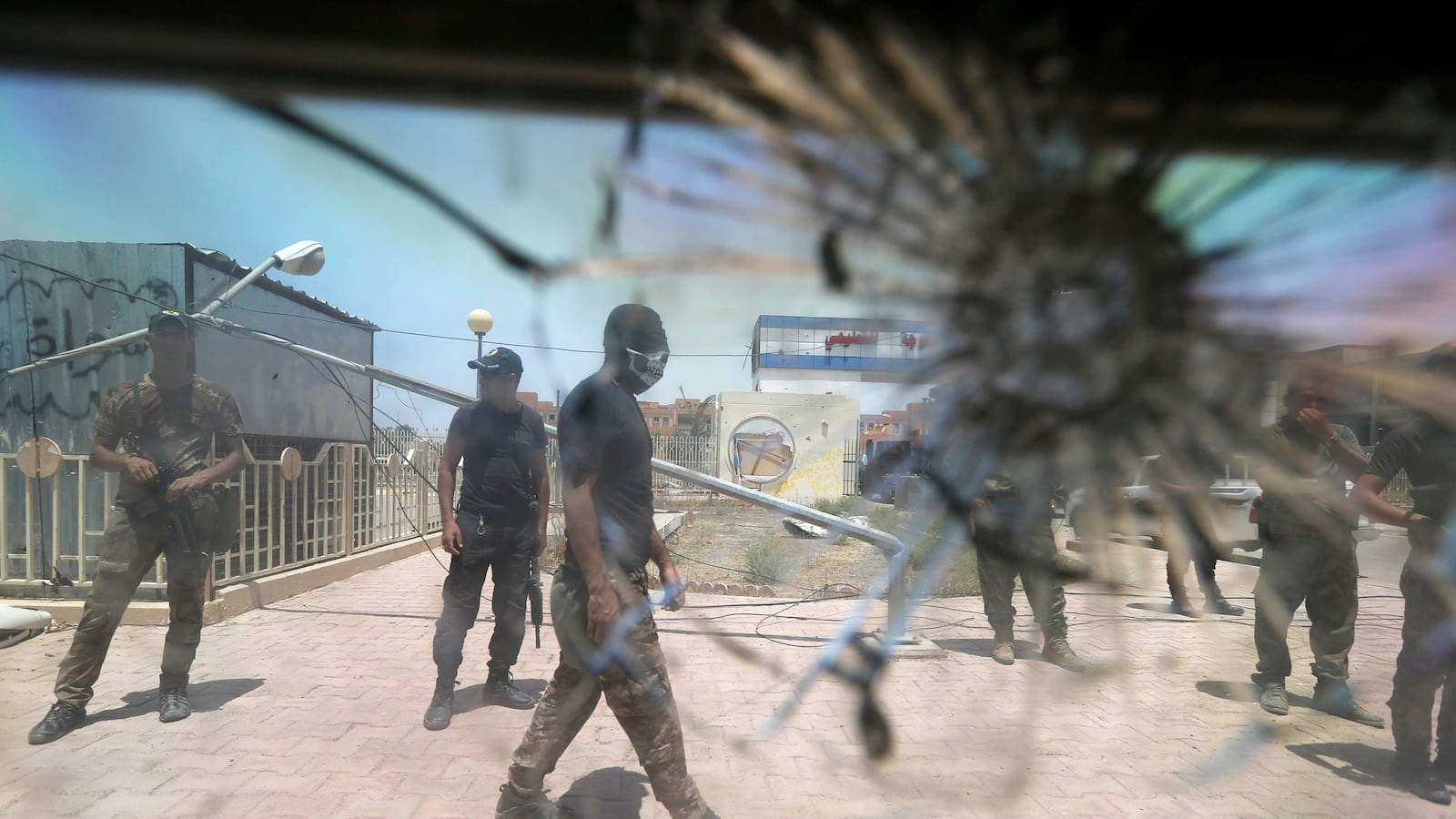The way Rasool Abdullah remembers it, he was in a hall with dozens of other men in an abandoned house outside Fallujah.
He was thirsty, as he had barely any water to drink for the past two days. The heat from the summer sun made the cramped quarters unlivable. His hands were tied tightly with zip ties, and from the rooms off the hallway, where he says people were being tortured, all he could hear was screaming.
“Ahmed is dead!” someone cried.

Rasool added Ahmed to his mental count. By the time he left 11 hours later, he says he’d lost the exact number of those who had fallen around him.
“Twelve or 13 people in the hall I was in died. I’m not including the people in the rooms,” he told The Daily Beast. “I don’t know their [full] names, only the number of people who are dead.”
While the recent liberation of Fallujah is being celebrated by governments from Washington to Baghdad, hundreds of civilians like those who were arrested with Rasool remain missing. The problem is that, unlike those taken by the so-called Islamic State widely known as ISIS, these civilians were arrested by Shiite pro-government militant groups operating as representatives of the Iraqi government.
In a list shared exclusively with The Daily Beast, the Anbar Provincial Council says it has identified 49 deaths carried out by pro-government paramilitary forces during the liberation of Fallujah, which Iraqi officials say has been completed today. Forty-six of them are listed with names, while three are simply identified by the Council as “Unidentified Body in the Amiriyat Fallujah Hospital.”
The Anbar Provincial Council has also publicly released a list of 643 names of those whose whereabouts are unknown, having been taken from the town of Saqliwia outside Fallujah.
“This list we have is the primary count of the people who are missing,” said a council member who asked to remain anonymous due to the sensitivity of the issue, “And we’re [still] counting.”
Claims of sectarian brutality by members of the government’s Popular Mobilization Units (PMUs)—an umbrella organization of pro-government militias that worked alongside the Iraqi Security Force to rid Fallujah of ISIS—are not just the one-time costs of liberating the Sunni-dominated city. Suggestions of the killing of innocents by Shiite groups within the PMUs potentially lay the seeds for continued anti-government anger in Fallujah, something U.S. officials fear could lead to a return of extremist groups like ISIS.
U.S. officials openly celebrated “progress in freeing” Fallujah, as Secretary of Defense Ash Carter said in a statement. Officials believe the campaign helps the Iraqi government and embattled Iraqi Prime Minister Haider al-Abadi. Privately, the reaction was tepid. There are fears among defense officials that ISIS made a calculated decision to abandon fighting against an armed force, backed with daily U.S.-led coalition airstrikes since the offensive began May 21. ISIS, the officials fear, plans eventually to return.
As one U.S. official told The Daily Beast: “If this is a rope-a-dope, then [ISIS] hopes we are George Foreman.” In other words, ISIS is banking on Iraqi forces, and their American partners, tiring of fighting for stability in Fallujah.
There are reasons to for U.S. officials to be nervous. The last time the Shiite-led government was responsible for security in Fallujah, sectarian tensions emerged and Fallujah became, in early 2014, the first Iraqi city where ISIS gained control of territory.
Even as Fallujah was falling again out of extremist hands, the finger-pointing over who was responsible for the death of Sunnis already had begun. While the militia responsible is officially unknown, survivors interviewed by The Daily Beast repeatedly pointed the finger at Kataib Hezbollah, one of the strongest Shiite-dominated militias in Iraq and the only such militia listed as a terrorist organization by the State Department. (Abu Mahdi al-Mohandis, the group’s commander, also happens to be a deputy chairman of the PMUs.)
In response, Kataib Hezbollah spokesman Jaffar al-Hussaini told The Daily Beast: “The government of Anbar knows that Kataib Hezbollah is in charge of killing more than 10,000 ISIS members. So the government of Anbar is trying to take revenge on Kataib Hezbollah, so they are claiming that Kataib Hezbollah did that [the Saqliwia disappearances] so they can take revenge for the 10,000 ISIS fighters.”
Hezbollah’s alleged framing by Anbaris and the Iraqi government at large goes further, Hussaini said, referencing two more cases where Kataib Hezbollah is allegedly responsible for the disappearance of hundreds: People “have been sold as detainees or missing people by the government so they can claim civil rights for them, actually they are ISIS fighters killed during battles.”
Asked for a copy of this list of fake detainees who were really dead ISIS fighters to compare it with the lists provided by the Anbar Council, Jaffar replied, “We cannot share it with you because it is not for media.”
For survivors of disappearances like Rasool, however, the memories are very real and very fresh.
“I saw a guy tortured with my own eyes. [The torturer] called him a pimp and [for that] he gets horns in his head. So he screwed a screw with a screwdriver into his head, like an inch or an inch and a half. He stomped on his head with his boot where he put the screw, and then he screwed the screw into his head with a screwdriver,” he said, “He hit me on the back with sticks and iron, and on the head with an iron tube. He put two cigarettes out in my left ear. When I was almost unconscious, he burned my knee with a piece of iron.”
Mohammad Falah, another survivor, remembered that “from morning until night they kept beating us with iron tubes, thick wires, and sharp objects. They killed some people with sharp objects… they hit the head and the kidney.”
When asked if he saw anyone die, Falah said he remembers three, reciting their names with no hesitation.
“Shakir Kamal Hais was killed. Subhaib Najam Abdullah Abd was killed. Laith Ismael Ubayd was killed,” he said. The Daily Beast later found all three of these men on the Anbar Council’s list as well.
According to the Anbar Council and the mayor of Ramadi, Dr. Ibrahim al-Awsaj, however, in addition to the 643 missing from Saqliwia and the 49 deaths, about 1,200 civilians have gone missing over the past year from the Razaza Checkpoint, a key checkpoint that many internally displaced Anbaris have had to use to get to Baghdad during the military operations in Anbar over the past year.
Kataib Hezbollah was responsible for two checkpoints here, said Jaffar al-Hussaini, the Hezbollah spokesman. But “not all the people who go missing in that area will be blamed on Hezbollah,” he said, adding, “The army is there and the government forces are there, and they have a list of names which they use there now.”
For his part, Brigadier General Yahya al-Rasoul, the spokesman for the Joint Operations Command responsible for the Anbar operations, strongly denied that the army had any role in the Razaza disappearances: “We have no involvement with any detainees at all in that area.”
The prime minister of Iraq has set up a committee to investigate the events in Saqliwia.
The deputy governor of Anbar, who is on the PM’s investigative committee, refused to give a comment on the progress of the committee.
Asked, however, if the committee’s investigation would include delving into the records of the myriad paramilitary groups like Kataib Hezbollah that had been stationed around Saqliwia when the disappearances occurred, all he could muster was a deep sigh and a muttered statement about how the investigation will continue.
Kataib Hezbollah, meanwhile, told The Daily Beast that it has been working directly with the PM’s investigative committee.
“We’ve been a part of the investigation. Our job was to make it easy for the committee to visit the buildings under our control, make it easy to talk to the families, and listen to the testimony of the families who stayed,” said Jaffar al-Hussaini. “We delivered the committee a list of names of ISIS members. Their families claim they are innocent, but we claim they are armed.”
For his part, with the war against ISIS finished in the city of Fallujah and throughout Anbar Province, the member of the Anbar Council who shared the list with The Daily Beast predicted that, sadly, if someone isn’t held responsible for these crimes, anger in Anbar might boil over once more.
“It’s not going to be on as large a scale as 2013 and 2014 [when massive anti-government protests in Anbar galvanized the population], because Anbari people right now—with the fight against ISIS—a lot of people have been killed,” he said. “[They’ve] reached the level of exhaustion.”






